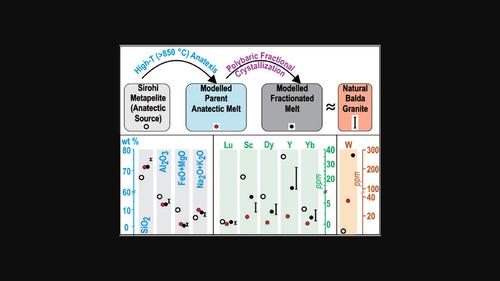Insights into the anatectic origin of granites parental to tungsten mineralization: A case study from the trans-Aravalli terrane, NW India
IF 0.8
4区 地球科学
Q3 GEOLOGY
引用次数: 0
Abstract
Potential progenitors for W (±Sn) deposits include peraluminous granites of S-type affinity. The anatectic origin of such granites parental to W mineralization has received little attention. This study focuses on Balda Granite (BG), a peraluminous intrusion parental to W-rich ore bodies in the Sirohi region (NW India). We reflect upon the potential source for BG and investigate its anatectic origin through open-system phase equilibria modeling. On the prograde path, muscovite- and biotite-dehydration reactions at 675–745°C and 755–870°C yield ~10 and 13 wt.% melt, respectively. Si, K, Al, and Fe contents of the cumulative melt increased with progressive anatexis. Modeling results suggest high-T (>800°C) stability of the peritectic garnet, which is abundantly observed in the leucosome-dominated migmatitic patches. Cumulative melt extracted till 868°C was chosen to model the crystal fractionation along three polybaric gradients of 30, 45, and 60°C/kbar. As the modeled anatectic melt cooled, its peraluminosity and maficity decreased progressively. With the intermediate cooling gradient of 45°C/kbar, the melt achieved complete crystallization at ~7 km, the depth at which the BG had been emplaced and evolved into a W-rich residual (fractionated) model melt. In terms of peraluminosity, and major and trace element (Lu, Sc, Dy, Y, Yb) chemistry, the fractionated (residual) model melt compares well with BG. This study also models the W concentration in the anatectic melt during its generation and fractional crystallization. We argue for the origin of BG through high-T anatexis of Sirohi Group metapelites and cooling (and fractional crystallization) of the parent anatectic melt at the maximum gradient of 45°C/kbar. Thus, a high-T anatectic origin of granites parental to W deposits may be more prevalent than so far inferred.

对钨矿化亲缘花岗岩古生代起源的见解:印度西北部跨阿拉瓦利(trans-Aravalli)地层的案例研究
W(±Sn)矿床的潜在原生体包括S型亲缘的过铝花岗岩。这类花岗岩是 W 矿化的母岩,但其寒武纪成因却很少受到关注。本研究的重点是 Balda 花岗岩(BG),它是印度西北部 Sirohi 地区富 W 矿体的亲铝侵入体。我们对 BG 的潜在来源进行了思考,并通过开放系统相平衡建模研究了它的无生界起源。在顺行路径上,675-745°C 和 755-870°C 温度下的黝帘石和生物岩脱水反应分别产生了 ~10 和 13 wt.% 的熔体。累积熔体中的硅、钾、铝和铁含量随着渐进式安山期而增加。建模结果表明,包晶石榴石具有高T(800°C)稳定性,这在以白云母为主的偏闪长岩斑块中大量存在。选择提取至 868°C 的累积熔体来模拟沿 30、45 和 60°C/kbar 三个多巴梯度的晶体分馏。随着建模的安山岩熔体冷却,其过铝度和黑云母度逐渐降低。在45°C/千巴的中间冷却梯度下,熔体在大约7千米处完全结晶,即BG的出露深度,并演化成富含W的残余(分馏)模型熔体。在过白度、主要元素和微量元素(Lu、Sc、Dy、Y、Yb)化学性质方面,分馏(残余)模型熔体与 BG 比较接近。这项研究还模拟了无极熔体在生成和分馏结晶过程中的 W 浓度。我们认为,BG 的起源是通过 Sirohi 组偏长岩的高 T 安山岩化和母体安山岩熔体在 45°C/kbar 的最大梯度下的冷却(和分馏结晶)。因此,W矿床母体花岗岩的高T安山岩起源可能比迄今推断的更为普遍。
本文章由计算机程序翻译,如有差异,请以英文原文为准。
求助全文
约1分钟内获得全文
求助全文
来源期刊

Resource Geology
地学-地质学
CiteScore
2.30
自引率
14.30%
发文量
18
审稿时长
12 months
期刊介绍:
Resource Geology is an international journal focusing on economic geology, geochemistry and environmental geology. Its purpose is to contribute to the promotion of earth sciences related to metallic and non-metallic mineral deposits mainly in Asia, Oceania and the Circum-Pacific region, although other parts of the world are also considered.
Launched in 1998 by the Society for Resource Geology, the journal is published quarterly in English, making it more accessible to the international geological community. The journal publishes high quality papers of interest to those engaged in research and exploration of mineral deposits.
 求助内容:
求助内容: 应助结果提醒方式:
应助结果提醒方式:


